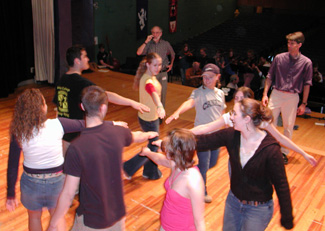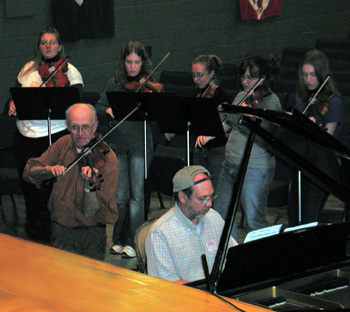|
TRADITIONAL DANCE AND
MUSIC OF QUEBEC AND FRANCE
FOR HIGH SCHOOL FRENCH LANGUAGE STUDENTS
Traditional Dances of Latin America for High School Spanish
Students
Traditional Dances of Germany, Italy, Russia and Other Parts
of the World
 Square
dancing originated in France! When settlers from France and
western Europe came to the new world, they brought their
quadrilles (square dance formation), their fiddles and their
dances. The cultural heritage of Francophone America is
brought to life in this dynamic participatory workshop.
Accompanied by the energetic Quebecois fiddling of George
Wilson and the pulsating rhythmic piano and guitar of Peter
Davis, Paul Rosenberg leads high school French students
through a series of lively dances as he points out the
origin of such phrases as “do-si-do” (which was originally
“dos à dos” – back-to-back). Dances are in square, circle,
and contra formations. This multidisciplinary workshop
encompasses language, history, geography, physical education
and, of course, music! Square
dancing originated in France! When settlers from France and
western Europe came to the new world, they brought their
quadrilles (square dance formation), their fiddles and their
dances. The cultural heritage of Francophone America is
brought to life in this dynamic participatory workshop.
Accompanied by the energetic Quebecois fiddling of George
Wilson and the pulsating rhythmic piano and guitar of Peter
Davis, Paul Rosenberg leads high school French students
through a series of lively dances as he points out the
origin of such phrases as “do-si-do” (which was originally
“dos à dos” – back-to-back). Dances are in square, circle,
and contra formations. This multidisciplinary workshop
encompasses language, history, geography, physical education
and, of course, music!
In
Latin America, some dances were brought over by Spanish
colonists, and others are ancient dances of native peoples
who were influenced by Spanish culture. Many of these dances
tend to be very energetic and lots of fun!
We also teach dances from Germany, Italy, Russia and more
than thirty other countries around the world.
FIDDLE FOR
ORCHESTRA STUDENTS
 Master
fiddler George Wilson has developed a program for working
with musicians in school orchestra programs. Students will
be introduced to and instructed in the nuances of
traditional fiddle styles. Master
fiddler George Wilson has developed a program for working
with musicians in school orchestra programs. Students will
be introduced to and instructed in the nuances of
traditional fiddle styles.
George
has an extensive background playing tunes from Quebec
(as well as
Ireland,
Scotland,
Cape Breton/Nova Scotia, Appalachia, Scandinavia and the
Shetland Islands). These traditional tunes include reels, jigs, hornpipes,
schottisches, marches, polkas and waltzes.
During
instruction, George will focus on the rhythms and accents
that give this traditional music its distinct feel. Sheet
music for melody and harmony/accompaniment will be provided;
George will also employ the more traditional method of
teaching tunes by ear. Students
will learn melody, harmony and accompaniment for each tune.
The details of bowing, ornamentation, rhythm, and accents
idiomatic to a style or tune will then be added.
These
workshops, rehearsals and sessions can be integrated with
history and geography units as well as being aligned with
the New York State Learning Standards in the areas of
multicultural and traditional music, improvisation and
playing solo or in an ensemble.
|

